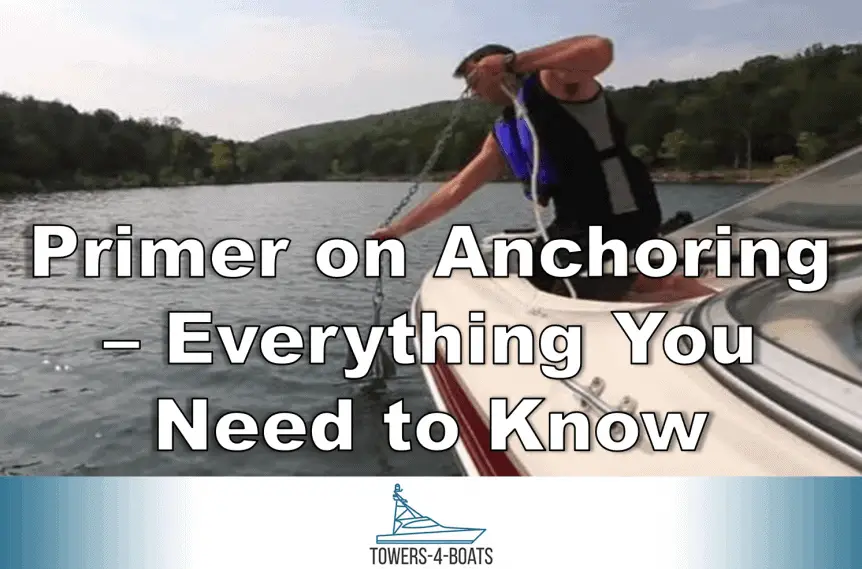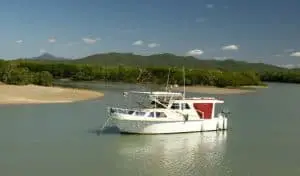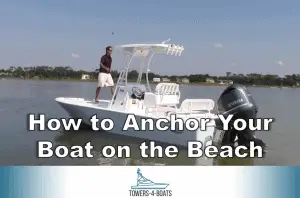Anchoring is a little bit of science and a little bit of art. Anchors come in a wide variety of shapes and sizes for every vessel. Once you’ve fought that battle, using the anchor requires analyzing a constantly fluctuating set of variables on the water.
But with a little research and some advanced planning, anyone can anchor a boat like a pro. Whether you want to stop for a refreshing swim or visit a new port for a week, here’s everything you need to know about how to anchor your boat securely.
What Makes an Anchoring System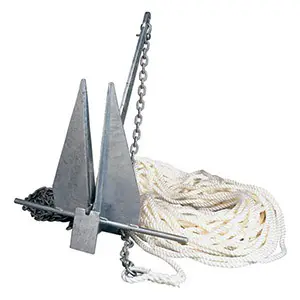
A lot more than just an anchor is needed to keep a boat secure. The boat’s anchoring system is commonly referred to as its ground tackle. Besides the anchor, the ground tackle includes the chain, rope, or rope and chain combination, and any connectors like shackles.
Bigger boats will need a method for retrieving their heavy anchors. Small setups can be raised and lowered by hand, but a mechanical or electrical windlass makes the job far more manageable. Large boats, especially those carrying all chain, require a windlass to get it back on board.
Learn More About Anchoring
Anchoring is a critical skill to master. To help you become better at it, I wrote some detailed How-To-Guides on some of the common situations where you’ll have to anchor your boat. Check them out if you’re interested.
How to anchor in wind
How to anchor your boat on the beach
Why Do Boaters Anchor?
Everyone needs to have a reliable anchoring system onboard the boat and know how to use it. But some people anchor more than others. You need to decide how you’re going to use your anchor before you and pick and set up the perfect system.
Emergency Anchor
Stuff goes wrong in boats. Just like airplane pilots practice emergency landings in case their engine fails them one day, so too should boaters practice anchoring with no power. An anchor should be ready to deploy from the bow at a moment’s notice. Even if you never plan to anchor, it should be there and ready to use, just like your lifevests.
Lunch Hook
The most common use of anchors is as a simple lunch hook. You plan to stop for some fishing, a quick swim to the beach, or to simply relax on the water a few minutes. You do not plan to stay long, and you are doing all of this in calm conditions.
If lunch hooking is your goal, you don’t need the biggest and fanciest gear. You need something that grabs easily and is easy to launch and retrieve. If the weather turns, chances are you’re just going to go back home.
Overnight Stays and Leaving the Boat
The next logical step, if you found a quiet cove that you enjoyed with your lunch hook, is to stay on the boat overnight. Sleeping aboard while at anchor is a magical experience.
But, assuming you want to get some sleep, you need to give your anchoring gear a little more thought. If weather moves in, or even just a random thunderstorm, you probably aren’t going to want to move the boat in the middle of the night. This means your ground tackle should always be set and prepared for the absolute worst conditions you may experience.
The same is true if you are going to leave your boat anchored on its own while you leave on another boat. You won’t be there should anything go wrong, so you need to make certain the boat will be there when you get back.
Extensive Cruising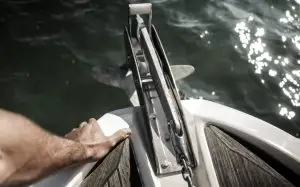
People go cruising in pretty much any sort of boat you can imagine. People camp out in 22-foot cuddy cabin motorboats and they live the high life on 60-foot sailing catamarans.
Cruising involves traveling into different areas, and that may mean having several different types of anchors on board. Anchors vary in their ability to hold in different bottom types. As you travel, you may find that your trusty home hook doesn’t work so well.
Cruisers must plan on the places they intend to travel and make their choices based on their ultimate usage. Perhaps they will need
Since cruisers are often leaving their boats unattended for a few hours and are always sleeping onboard, they tend to opt for the largest anchor they can carry attached with an all-chain rode. They also tend to carry several anchors on board, just in case one gets lost or they come across a situation where they need to put two down.
Long-Term Storage
Storing your boat at anchor is tricky business, especially if it’s going to be unattended for days or more. While the same guidelines can be applied for storage as for cruisers, a mooring is far better suited for storing a boat and leaving it unattended.
Moorings are permanently attached to the bottom. They can be made by simple weights dropped, like huge concrete blocks. Special anchors can be used, like mushroom anchors. The best moorings, however, are helical screws driven into the seabed and set with cement.
Storing a boat for an extended period means minimizing chafe on the lines and equipment. The boat will swing with each wind change, so lines cannot become twisted or bound. A mooring ball or other type of float, a chain rode, and swivels are used to accomplish this.
Terms and Definitions
Anchor–The hook designed to grab the seabed and hold the boat in place
Bahamian Mooring–Using two anchors, set at 45 or 90 degrees from one another, to hold the boat in place. This provides two different directions of holding in situations where wind or tidal current shifts are expected.
Bottom Composition–What sort of material makes up the bottom, i.e., mud, clay, sand, rocks, or weeds. Knowing the bottom composition is critical so that you can choose an anchor that will hold well in it. Some bottom types, like scoured rock or hard-packed sand, will not allow any anchor type to set.
Bridle–A design of snubber that uses two lines between each side of the bow. This is common on catamarans but can be useful for distributing the load and reducing stresses on any boat’s deck gear.
Chafe–The wear that occurs on moving lines where the impact another line, a part of the boat, or the seabed. In storm conditions, nylon lines can chafe through in a matter of hours.
Drag–In anchoring, a dragging anchor indicates a failure of the anchoring system. It is usually caused by having too little scope out, but could also be caused by having too small and anchor for the given conditions. When you anchor drags, your boat is no longer where you left it.
Mediterranean Mooring–The Med moor is using a bow anchor to hold the front of the boat off while you tie the stern to the quay or dock. This isn’t very common in the US, but using an anchor to help keep you off a dock or a seawall is a handy skill to have.
Mooring–As a verb, “mooring” simply refers to the act of securing the boat someway. As a noun, a mooring is a secure permanent anchor on the bottom that you can attach to.
Rode–The line that attaches the anchor to the boat. It can be nylon rope, chain, or a combination of the two. How much rode you need to put out depends on the desired scope.
Scope–The scope of your rode is the ratio of its length to the distance from the bow roller to the seabed. This distance is your freeboard plus the depth of the water. You must also include any tidal fluctuations and plan for high tide.
Set–An anchor is “set” when it is securely dug into the bottom and will not move in wind gusts or with sudden pulls. For more information on how to set your anchor properly, see our article on How to Anchor a Boat in Wind.
Shackle–A shackle is a link that secures the chain to the anchor. These should always be load-tested galvanized shackles. Shackles should always be considered a weak link in your anchoring system.
Snubber–For those with all-chain rodes, a snubber is a short piece of nylon line used between the chain and the deck cleat. This stretches enough to make the boat ride easier in waves and gusts of wind. Additionally, it reduces load stresses on the deck gear, including the windlass, bow roller, and the deck cleats.
Swivel–Some boaters use anchor swivels instead of shackles to attach their chain to the anchor. The advantage of the swivel is that it allows the anchor to rotate freely when setting and when entering the bow roller on retrieval. Ideally, this also keeps the chain straight in the windlass.
Windlass–Windlasses are mechanical or electric winches used to help you retrieve a heavy anchor. Even electric models usually have a manual emergency backup mode.
Different Types of Anchors
Generally speaking, anchor designs can be divided into two different families. The traditional anchors have been around for generations. Many are very popular and used today. Typically they were designed to work for a specific type of bottom.
Modern anchor designs, on the other hand, are designed to work in a range of bottom conditions. Some manufacturers claim that their anchors can be trusted to reset on their own, and while this may be true, we are not ready yet to trust them in every circumstance. But the more advanced designs of these anchors allow their weights to be distributed unevenly. That means that they roll themselves upright on the bottom and set faster than traditional anchors. Their holding power usually comes from broad flukes that dig themselves under the bottom and hook, meaning that pound for pound modern designs generally hold better.
While the name brands for the anchors are named below, as these anchors are usually referred to them by, it should be noted that many knock-off and generic brands exist as well. This is not an all-inclusive list, but it does contain a majority of the anchor types you are likely to encounter.
Traditional Anchors
Fisherman–These anchors tend to look like the classic anchor clip-art, the sort of anchor you’d expect to see on a Spanish galleon or pirate ship. They work by hooking themselves into the bottom and are one of the only anchor types that work in rocks and thick grass.
Danforth–Since they fold flat and store easily, you’ll find a Danforth-style anchor on nearly every small boat. They work by digging the sharp points of their flukes into the bottom. Unfortunately, they are easily fouled with weeds, rocks, or lines. The work very well for lunch hooks in sandy areas or spots with thick mud. Fortress is a popular brand of Danforth-type anchor that is made of aluminum and is therefore lightweight, making it easy to store and handle.
Bruce–Bruce anchors have a scoop fluke that holds exceptionally well in mud or clay. They do not have points, however, and don’t work well in bottoms that are hard to dig into. While Bruce stopped making anchors, the Claw anchor is a very similar design.
Delta–The Delta looks similar to the Bruce, but the flukes come to a sharp point. This gives the best of both worlds in that it holds very well but can also dig into packed sand, weeds, and even some grass.
CQR–The CQR is a modified Delta whose fluke is mounted on a pivot. This allows the anchor to set quickly.
Modern Anchors
Rocna–The distinctive Rocna is nearly ubiquitous on cruising vessels. They feature a large roll bar mounted on top of a pointed fluke. The roll bar forces the anchor to rotate when on the bottom, forcing the point down and increasing the chances that it will dig in and set.
Mantus–The Mantus is also a roll bar anchor, but is made of separate pieces that are bolted together. Large Mantus anchors can be broken down for storage.
Spade–The Spade anchor is often confused for a Delta. However, the design is very different. Spade anchors have most of their weight in the tip of their fluke, which forces the anchor to set quickly. Spade anchors lack the roll bar and therefore fit in many bow rollers easier than others. Both Rocna and Mantus now make secondary models, the Vulcan and the M2, respectively, that lack the roll bar and are very similar to the original Spade anchor.
Anchor Material
Nearly all anchors are made of galvanized steel. This provides maximum strength and rust-free operation for years. Some anchors are available in aluminum or stainless steel versions, as well. Aluminum offers a lightweight option, so it is only available with anchors that can offer sufficient holding power through their flukes. Regardless, aluminum is not as strong as galvanized steel and can be bent or damaged. Stainless is also not as strong as galvanized steel and is generally far more expensive. Stainless anchors are made to look good on your anchor roller but offer no advantages once they are below the surface.
How to Pick an Anchor
The design of the anchor you pick is mostly determined by the bottom composition of your boating area. Charts and cruising guides can tell you what sorts of bottom you can expect. If the bottom is of varying types, you might need to invest in a few different anchors.
Nearly all anchors work fine in sand, mud, and clay. Soft sand and mud are problems for some. Weeds and grass are problems for most of them.
Once you have a clearer idea of what sort of bottom you are dealing with, you can consult the anchor manufacturers’ websites for details on each design. You can also stroll around your local marina to see what anchors are commonly used. Talk with cruisers and sailors from the area and see what others have found to work well in your home waters.
Check out our article Ground Tackle for more information on how to set up the best system for your boat.
How to Anchor
Perhaps even more daunting than choosing your anchor or getting it set is picking where to do your anchoring. It is an individual choice you make every time you set out. Many variables are at play each time, from where the wind and seas are coming from to where you want to be to visit a port.
For more information to help you choose the best spot and how to avoid a dangerous situation while anchoring, see our article Picking the Best Spot to Anchor.
For a step by step how-to on Anchoring a Boat in Wind like a pro, check out our article.
Of course, this may be a bit too in-depth for some folks looking to just stop by the beach for a few cold ones. If you want to beach your boat and make sure you can get off easily, take a look at our article on How to Anchor a Boat on the beach.
Anchoring Tips and Techniques
Practice Courteous Anchoring
Entering a crowded anchorage and finding room for your boat to swing safely isn’t as easy as it looks. As a general rule, what you want to do is give everyone else as much room as you possibly can. If you come across a nearly empty anchorage with only one other boat, don’t anchor next to the boat. Anchor on your own, on the other end of the anchorage, and give everyone as much swing room as you possibly can.
But of course, that’s not always an option in popular ports. You must determine how much scope you need for the depth, wind conditions, bottom conditions, and type of gear you have. You cannot know what choices others have made or how much line they have out. Likewise, you can’t have faith that if the wind picks up, they won’t drag.
The result is that, as you approach a new anchorage and see other boats, you have to make some assumptions about how much like they have out and where their anchors lay. You then have to visualize their swing circles as the wind changes and find room for you.
It’s normally easier than it sounds, but contrary winds and currents can make boats swing around differently than their neighbors. Catamarans and powerboats might swing on the wind, while sailboats and trawlers swing on the current. Some boats also need extra space since they swing wildly in wind gusts.
The general rule of thumb is that the last boat into an anchorage is the first one to move should boats get too close to each other. So never be afraid to change spots until you get it right.
Anchor Like Everyone Else
Another thing that can muck up a crowded anchorage quickly is if boaters use different types of anchoring techniques. If everyone in the anchorage is riding on a single bow anchor, don’t try to be fancy and set out two anchors. Even if that might be the better solution for the conditions, the boat on one anchor will remain stationary while everyone else swings in an arc or circle. The guy on two anchors is likely to get crashed into.
The same problem occurs in mooring fields. If everyone is on a mooring, and you try to anchor in the middle, your boat is likely to swing and strike boats on moorings. On anchor, you swing in a circle, but boats on moorings tend to remain very close to the same position.
Always Anchor Like it’s Blowing 50+
If you’re just stopping for a few hours, you can probably get away with a small anchor on a short rode. But if staying overnight or longer is in your plans, always over-prepare. Storms can roll through very rapidly, and even an average summer thunderstorm can pack gusts well over 50 knots. It’s far easier to over-prepare than it is to frantically get ready as the thunderstorm approaches.
Power Set Your Anchor
As previously mentioned, anchors need to be set well in order to get their maximum holding power. To ensure this happens, you need to let out your rode and let the boat fall back on the line. As the line become taut, engage your engines in reverse. Don’t be delicate, you want to simulate strong winds. As you back down, make sure the boat is not moving.
If the bottom is very soft, you may notice that the anchor does not set immediately. Another technique is to allow the anchor to sink into the mud and much for 20 or 30 minutes. Then go back and try to power set the anchor. Chances are, it has worked its way far enough below the surface to grab now.
If it Doesn’t Set, Try Another Spot
Of course, you can’t anchor in some places. Whether the bottom is too soft to hold your anchor or too hard to grab it, never be afraid of trying somewhere else.
Maintain an Anchor Watch
Once you’ve got the anchor down and the engine off, it’s time to relax. But don’t stop paying attention, especially if the wind shifts or the weather changes. Make sure your boat is always exactly where you expect it to be.
GPS units can be very helpful for this purpose. Many have built-in anchor alarms, and you can monitor the boat’s speed and position with great accuracy.
Inspect Your Gear Often
Every time you use your anchor, inspect it’s components carefully. Any worn points or chafed line needs to be taken care of immediately. Shackle pins are especially prone to wiggling free, so make sure they are secured with stainless seizing wire.
What if Your Anchor Drags?
Sometimes, things don’t work out. If your boat is dragging, you have to figure out why it is happening. The most common reason is that you did not put out enough scope. The solution is equally as simple. All you need to do is let out some more line.
Of course, some bottoms will not hold an anchor. And it’s also possible that your anchor has become fouled on something and is no longer grabbing. If letting out more line doesn’t help, you’ll need to retrieve your anchor and start over again somewhere else.
Conclusion
While the art of anchoring might seem like a lot to learn, doing it well can add comfort and safety to your boating adventures. Like many things, the more you learn and practice, the more naturally it comes to you. Soon, you’ll be anchoring like a pro without a second thought, and you’ll be confident in the knowledge that your boat will stay exactly where you left it.

